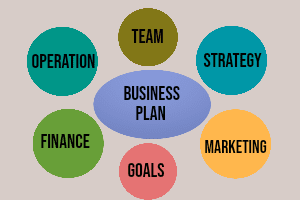 |
| What is a business plan? |
Definition of a business plan
Small Business Management has now become a science. With the development of the Internet and the use of digital devices, small business management has also added new features. Small business management is now a digital skill. Like other digital skills, it needs to be learned. Our website Digital skills PK online is constantly writing articles on Small Business Management so that people can learn online and enhance or refresh their knowledge.
As it can do no work without planning, be it a small business or a big company, a first business plan is very important. With the growth of online services, many business writers offer their services to write a comprehensive business plan. Many business plan templates and samples are available on different websites for users.
Let us know about the business plan in this article
What is a business plan?
A business plan is a written document that outlines the goals of the company, how they will be reached, and when they will be achieved. It provides information about the organization’s history, financial projections, and the techniques the organization plans to use to meet its objectives. This complete document acts as a road map (a plan) that gives the company direction.
To get a bank loan or other type of finance, written business plans are frequently necessary. The creation of a business plan can be facilitated by using templates and instructions, such as those provided by the Small Business Administration in the United States.
Plans for businesses may have an internal or external focus. Plans with an external focus define objectives that are significant to external stakeholders, particularly those with financial interests. These plans frequently include specific information about the efforts the team or organization is making to achieve its objectives. External stakeholders in for-profit entities include investors and clients; in non-profits, they are donors and clients; and in government organizations, they are taxpayers, higher-up government agencies, and international lending organizations like the International Monetary Fund, the World Bank, various United Nations economic agencies, and development banks.
Internally focused business plans concentrate on the intermediate objectives needed to achieve the outward objectives. They might deal with the creation of a new service, a new product, an IT system, a financial restructuring, a factory renovation, or an organizational restructuring. A balanced scorecard, an OGSM, or a list of crucial success elements are frequently prepared in tandem with an internally focused business strategy. This enables non-financial metrics to be used to assess the plan’s success.
Strategic plans are business plans that identify and prioritize internal objectives but only offer broad recommendations for how they will be achieved.
The objectives of a working group, department, or internal organization are described in operational plans. Project plans also referred to as project frameworks, outline the objectives of a certain project. They might also talk about how the project fits into the organization’s overall strategic objectives.
What do we include in a business plan?
Your business plan should include information on how you will grow your company when you will accomplish it, who will be involved, and how you will handle the cash.
If you’re seeking money or investments, clarity on these matters is very crucial. It will bring your emphasis on how your new company should run to offer it the best chance of success into sharper focus as you develop your plan.
A business plan must include:
- An executive summary is a synopsis of the company you plan to launch. It’s crucial. Read the business plan executive summary to see how many lenders and investors base their decisions about your company only on this area of the plan.
- Your vision and company idea should include a summary of who you are, what you intend to sell or offer, why, and to whom, as well as your business goals and major selling points.
- Your business’s markets, competitors, market trends, and tactics (like pricing, distribution, and promotion) are all covered in your marketing and sales strategy. For more information, see your business’s markets, competitors, and marketing and sales.
- See the section on your team’s skills in the business plan for information on your management team, personnel, and credentials.
- See business plan: your operations for details on your locations, production facilities, management information systems, and IT.
- Financial forecasts: For information on profit-and-loss accounts, balance sheets, and cash flow projections, check the section on financial forecasts for your business plan.
4. Benefits of creating a business plan
- The overall picture: This is one of a business plan’s major benefits. You can get a better understanding of your company when you plan your business. Everything is simpler to figure out and you can connect the dots between strategy and tactics with ease.
- Strategic focus: As a startup, you must develop an identity and concentrate on strengthening it. Your target market and the goods and services you are developing to meet their needs will define it.
- Establish priorities: In a firm, it’s impossible to handle everything at once. Planning your business allows you to prioritize tasks and spend time, resources, and effort productively and smartly.
- Manage change: When you plan your business well, you can verify your hypotheses, monitor your progress, and identify recent developments away, enabling you to make adjustments.
- Forces you to take responsibility. When you plan well, you establish goals for yourself and a way to monitor your progress. You can reevaluate your business plan by considering your expectations and actual outcomes.
5. Tips for creating a business plan
It’s time to think about how you’ll put the business plan together now that you know what elements we customarily included in one.
Here are some important considerations for drafting a business strategy. These guiding principles will assist you in creating a business plan that accomplishes your goals (whatever they may be) and serves as a handy guide.
1. Don’t be long-winded
Use clear, concise language and avoid jargon. When business plans are too lengthy, they’re less possible to be used as planned and more workable to be skipped or glazed over by stakeholders.
2. Show why you care
Let your excitement for your business shine through; show employees and investors why you care (and why they should too).
3. Cite any supporting documentation
Don’t be afraid to include a long list of appendices, such as team members’ resumes, customer personas that have been developed, product examples, and instances of internal or external communications.
4. Reference information
All market, competition, and customer-related information should make use of reliable, pertinent data points.
5. Conduct more research.
You should spend more time conducting research for your business plan than actually creating it. Think about keeping a record of your research as proof.
6. Clearly state how you differ from others.
It’s critical to emphasize how your product or service sets you apart from the competition and helps your target market solve an issue whenever possible. Don’t be afraid to mention these distinctive qualities again and again throughout the strategy.
7. Conduct unbiased research.
As vital as it is to highlight your business and the advantages you offer your clients, it’s equally crucial to be aimed when citing the statistics and research. Showcase both the positive and negative aspects of your market analysis and financials; you want your shareholders to know that you have considered every conceivable possibility.
6. Conclusion for a Business Plan
Your business plan’s conclusion should encapsulate your general justification for why your venture will succeed to draw in drawing in investors or motivating staff. It should also preview the future and describe your goals for development and progress. The ending should emphasize your company’s unique selling propositions and leave the readers with a favorable impression.
It should include the summary of your firm and its likelihood of success in the business plan’s conclusion. It should contain details about your target market, current financial status, and future development or growth objectives. To support your claims, you should also provide some data and statistics. Maintain a positive, upbeat tone, and conclude with a call to action.
With this knowledge, hope you can produce a convincing conclusion that will leave the reader eager to invest in or support your firm.


.png)


0 Comments